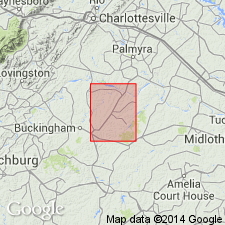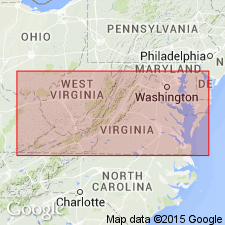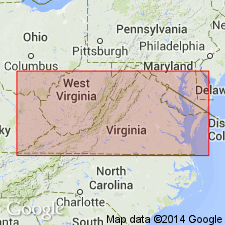
- Usage in publication:
-
- Buffards Formation
- Modifications:
-
- Original reference
- Dominant lithology:
-
- Schist
- Phyllite
- AAPG geologic province:
-
- Piedmont-Blue Ridge province
Summary:
Pg. 32-35, 48. Buffards Formation. A conglomeratic quartz-muscovite schist and phyllite. Stretched-pebble and bedding cleavage lineations indicate synclinal structure. Forms ridges in northeast-southwest-trending belt. Thickness 460 m. Unconformably overlies the Arvonia Formation. Upper contact is not exposed. Age is Silurian.
Type locality: Buffards Mountain, at summit near water tower, 5.6 km northwest of Dillwyn, Buckingham Co., central VA.
Source: US geologic names lexicon (USGS Bull. 1520, p. 42).

- Usage in publication:
-
- Buffards Formation
- Modifications:
-
- Not used
- AAPG geologic province:
-
- Piedmont-Blue Ridge province
Summary:
Pg. 39. Rocks of Buffards Formation (Brown, 1969) are reallocated to Arvonia Formation. [See entry under Arvonia.]
Source: Publication.

- Usage in publication:
-
- Buffards Conglomerate Member
- Modifications:
-
- Revised
- AAPG geologic province:
-
- Piedmont-Blue Ridge province
Summary:
Pg. 23. Buffards Conglomerate Member of Arvonia Formation. Assigned member status in basal part of formation. Age is Middle(?) or Late Ordovician.
Source: GNC index card files (USGS-Reston).

- Usage in publication:
-
- Buffards Formation
- Modifications:
-
- Areal extent
- AAPG geologic province:
-
- Piedmont-Blue Ridge province
Summary:
Buffards Formation includes greenish-gray conglomeratic quartzose muscovite schist containing ellipsoidal clasts of milky quartz, dusky-red quartzite, dark-gray aphanitic rock, and greenish-gray phyllite; greenish-gray chlorite-muscovite schist with medium to fine, grayish-blue quartz grains; grayish-green chlorite-muscovite phyllite; and biotite-muscovite-quartz schist. Contains tuffaceous and ferruginous-quartzite clasts similar to rocks that occur in the unconformably underlying Chopawamsic Formation. Interpreted as submarine fan channel deposit. Age is Ordovician.
Source: GNU records (USGS DDS-6; Reston GNULEX).
For more information, please contact Nancy Stamm, Geologic Names Committee Secretary.
Asterisk (*) indicates published by U.S. Geological Survey authors.
"No current usage" (†) implies that a name has been abandoned or has fallen into disuse. Former usage and, if known, replacement name given in parentheses ( ).
Slash (/) indicates name conflicts with nomenclatural guidelines (CSN, 1933; ACSN, 1961, 1970; NACSN, 1983, 2005, 2021). May be explained within brackets ([ ]).

